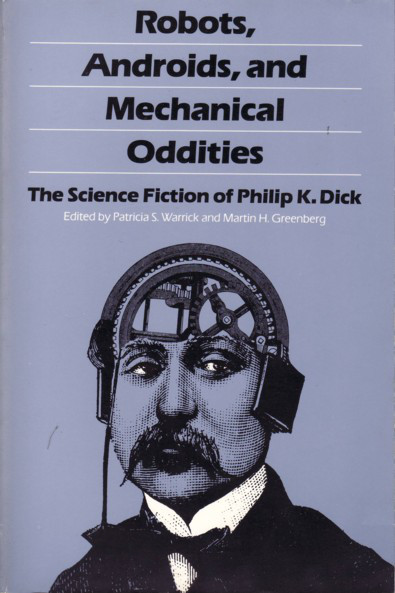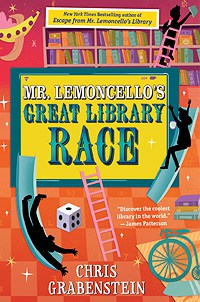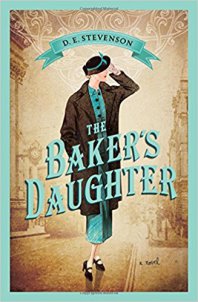The PKD series continues with a rather expensive academic book that I loaned out and never saw again.
Don’t loan your books out, kids.
Raw Feed (1989): Robots, Androids, and Mechanical Oddities: The Science Fiction of Philip K. Dick, eds. Patricia S. Warwick and Martin H. Greenberg, 1984.
“Introduction“, Patricia S. Warrick and Martin H. Greenberg — Despite the glib and (at least as far as I can tell from my reading of Dick’s work so far) silly assertion that Dick’s war robots are similar to machines planned by the military and the retreading of the now familiar analysis of Dick’s theme (the nature of reality and humanity), this introduction did have two valid observations. [The older Marzaat certainly thinks we have lurched a lot closer to Dick’s killer machines.] The first is that Dick believed that to preserve your humanness you had to forswear allegiance to any ideology, be unpredictable (unlike the machine which is programmed for predictability), unconstrained by predictability. This explains the characterization of Dick’s protagonists whom we are supposed to empathize with. The second is the point that Dick has a definite propensity to confuse the line between human and machine (a crucial element of his Do Androids Dream of Electric Sheep?) with machines being quite human and humans being cold and unempathetic.
“The Little Movement” — More of a fantasy than sf story . We never find out exactly where the toy soldiers come from, their larger purpose, or if they are part of a larger plot. This story is not particularly moving, but it does show some Dick characteristics: the dangerous toy whose harmless appearance is deceiving; mysterious, battling forces present in the universe with humans in the middle; and the hint of Dick’s concern with individual perceptions of the world with the in passing reference to the different worlds of adults and children. And, of course, there is a oh-so Dick baroque plot twist at the end.
“The Defenders” — I’d heard about this story and read Dick’s The Penultimate Truth so the main plot feature of this story — that robots were faking a war to keep humans underground — was not a surprise. What was a surprise is, unlike in The Penultimate Truth, the robots are not doing this at the behest of manipulative, selfish masters but for altruistic reasons. Ironically, Dick, the anti-authoritarian, sees the initiation of the One World state as good and his characters pragmatically unite to rebuild the destruction and wildly exalt in the possibilities of the future. Unlike the vicious robots of The Penultimate Truth, these robots are kind but firm and view man as needing one final temper tantrum before uniting into one culture. (I don’t buy Dick’s argument that cultures who lose moral goals opt to civil war.) [I’d say it’s when cultures differ on moral goals.]
“The Preserving Machine” — A light hearted story (with a black statement) showing Dick’s love of music. I fully agree with music being a wonderful, terribly fragile product of culture. [No, I’m not sure what younger self meant by “terribly fragile” — subject to the availability of technology? musicians?] I liked the fantastic notion of a machine turning music into animals (with oddly appropriate results including the final scene of the Beethoven beetle building a mud hut). Yet the story has a odd, rather depressing theme if I’m interpreting it right: the beautiful products of man’s cultures — the art, ethics, philosophy — are all fragile and, like living forms, respond to evolutionary pressures of the environment and mutate into unrecognizable forms. Dick’s depressing conclusion seems to be that art is doomed. He ties this into a curious religious point: that God must have felt humiliation and sadness at seeing his creation in the Garden of Eden respond to evolutionary pressure. A strange conclusion I’m not sure I agree with. But I do agree culture is fragile.
“Second Variety” — If you read enough Philip K. Dick, you begin to become familiar with some of the turnings of his mind, anticipate his plot twists. That was partially the case here. I did immediately suspect the first David (with the disturbingly lethal Teddy bear) of being a crab. Towards the end I suspected Tasso. However, Dick still managed to catch me by surprise with Klaus being a crab, and I thought Dick was going to be sneaky and simply have no second variety crab — have the implication of the second variety’s existence be a plot to demoralize both sides and create general paranoia. Speaking of paranoia, this had some fine, powerful moments of such on a par with John Carpenter’s The Thing. The plot of robotic soldiers slaughtering humans while disguised as such reminding me of another movie: The Terminator (at least as much resemblance as Harlan Ellison’s “Soldier”). [Harlan Ellison famously sued director James Cameron which is why later prints of the movie acknowledge the works of Harlan Ellison.] Dick did a very effective job of describing the bleak, post-nuclear landscape and the violence, confusion, and rush of combat. Clearly the crabs are a stark example of Dick’s theme of thanatos: they are animal-like creatures utterly dedicated to destroying life, the ultimate realization of the Frankenstein theme, a weapon turned against both sides. They may, has Major Hendricks implies, have unrealized potentialities they will realize after the war, but we don’t see them. Indeed, the fact, like all other life forms, they’ve taken to killing each other seems a good thing at story’s end. However, that introduces an ambiguous note: are the crabs just another life form (they certainly are creepy) albeit made of metal? Has man introduced them only in his folly? Or has he served as a creator, passing man’s torch on (probably not a valid reading given Dick’s stated use of the robot/android metaphor)? Tasso does say we always did nice work. Irony or gratitude from created to creator? Ah, that Dick ambiguity. I do not, incidentally, see Tasso — as the story notes state — as a prototype for Dick’s consuming female. The characterization isn’t very similar.
“Imposter” — A line from Blade Runner (though not scripted by Dick it accurately conveys his sensibilities) kept coming to mind when reading this: “How can it not know what it is?” Despite the rather telegraphing title, knowledge of Dick’s plotting proclivities, and a vague knowledge of this story from reading past criticisms, this story still caught me by surprise at the end. I thought, all through the story, that Spence Olham was a robot but, at story’s end when the real Olham’s body is first thought to be the robot’s, I thought he was human. Dick gets you whatever your original preconception was — a typical feature of his stories. I thought the portrayal of a self-deceived machine feeling unjustly persecuted was poignant. I also found it ironical that self-knowledge was what finally triggered the U-Bomb. A notion occurred to me that the robot could be a metaphor for all those evil people who really, truly don’t feel they’re evil, a threat, and are being persecuted.
“Service Call” — This is one of those stories about a visitor from the future who can’t even really be questioned because human culture has changed so much. I liked this story a great deal. The idea of eliminating war (an extreme manifestation of disagreement) by imposing ideological (of whatever flavor) conformity is ironic given Dick’s values. He hated war, but he also hated conformity. This story has some of the moral ambiguity of Dick’s “The Last of the Masters“: good achieved at perhaps too high a cost. The idea of having a machine, willingly buying it, to insure your ideological conformity is both scary and funny (“Why be half loyal?”) and great entertainment. The end, with the swibble consortium securing their past, was unexpected.
“Autofac” — Another very good story in which Dick invests his machines with animal-like qualities. Here the autofacs (I was reminded of the delightfully crazed autofac — the only part of the novel I really remember — in Philip K. Dick and Roger Zelazny’s Dies Irae.) plan, war (like the crabs in “Second Variety” waging war on each other seems a major step in becoming another lifeform), and reproduce. This is another story of Dick’s where people try to thrust off oppression, succeed, and don’t get the expected results. Rebellion, good, evil are not clear cut things in Dick’s life. There is also an intriguing element of satire: the factories of production protecting themselves, reproducing, serving humans second, an economic system perpetuating itself. Given Dick’s view and economic separation) from the conspicuous consumption of the fifties, this is an outsider’s disapproving look at that cultural phenomenon (this story was written in 1956). I also thought Dick’s description of the bleak, blasted landscape and the many trappings of the autofacs was quite effective.
“To Serve the Masters” — This is another one of Dick’s many stories with an ambiguous ending. The robots may have been irrationally destroyed by man because of religious fanaticism or they may have truly been a threat to man. There is a hint, as the story’s introduction says, that the former is true with the brutality of the humans. There is little more to this story than Dick’s well-crafted (the injured robot was rather poignant) ambiguity and plot twists.
“War Game” — This is another of Dick’s lethal (well, here only subversive) toy stories. The idea of a Monopoly-like game that manipulates people psychologically to facilitate economic conquest via surrender was interesting, but Dick didn’t sufficiently work out the details of how the game could do so. Maybe Dick’s point was the power of games to shape world views.
“The Electric Ant” — I disagree with Warrick’s and Greenberg’s contention that this is the most important and powerful short story in Dick’s corpus. I can think of better stories in this anthology alone. It certainly is, as they say, quintessential Dick, but this story has several problems which make it a prime example of Dick’s thematic obsessions imperfectly realized in a story. Dick entirely ignores the question of pre-destination which logically arises from the plot. If all of Garson Poole’s stimuli are punched on tape then all of his stimuli is predetermined. Also Dick, in the act of expressing his theme, ignores the idea of blocked perception not being the same as the unperceived object not existing. Dick, I believe following the path of Hume (but I couldn’t say for sure being woefully ignorant of philosophy) equates unperceived with non-existence. Also, someone had to construct Poole so there is an objective reality somewhere. This story exhibits too much ambition on Dick’s part. He tries to incorporate too much of his philosophical concerns at the expense of the story which is interesting but ultimately a failure.
“The Exit Door Leads In” — A strange, at times funny, story by Dick of a college of the future where the moral and psychological education of an individual is even more important than vocational knowledge. (The idea of an institution conducting secret moral and psychological tests is hardly a new one in sf.) You kind of feel sorry and depressed at Bob Bibleman’s (an obvious bit of symbolism, the Bible being the ultimate manifestation of institutionally encoded morality) fate. Dick makes us empathize with him and then assigns him back to the dump mercilessly. In most sf stories of this type, the protagonist passes the secret test. Bibleman disappoints Mary Lorne and gets the cold approval of a robot at story’s end. When the test was revealed, I thought Dick was going to go for a typical — for him — ending and make you wonder if the Panther Engine was real and Bibleman’s expelling a retaliation or if the stated facts were true.
“Frozen Journey” — A fitting end for the anthology. This story of a man wracked by guilt and plagued by an increasingly inaccurate perception of reality seems a spiritual autobiography of Dick in his last years. [Let me repeat that Tim Powers, who knew Dick in his last years, said he was definitely not crazy.] Victor Kemming’s life of fear and anxiety, of spiritual visitations, of agony over his complicity in the death of a bird (a pointed reminder of how Dick valued life), seems Dick incarnate. The story is quite sad in its depiction of psychological deterioration and severed relationships. Like Dick’s life, it is poignant and blackly funny.
More reviews of fantastic fiction are indexed by title and author/editor.
Advertisements Share this:





